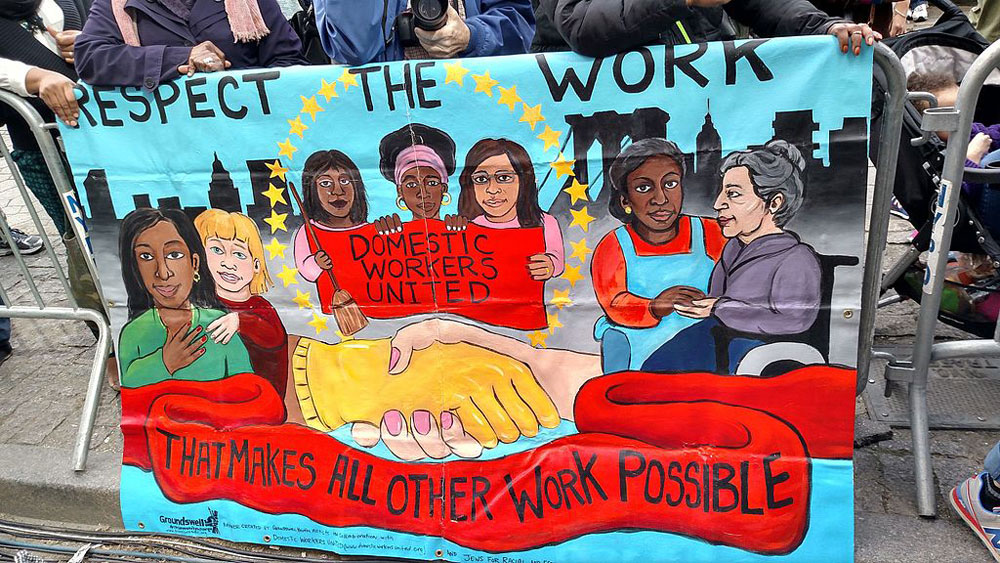
Back in July 2009, as the nation was emerging from the depths of the Great Recession, the federal minimum wage increased by 70 cents to $7.25 per hour. Today, there it sits, unchanged 12 years later. Initially included in President Joe Biden’s $1.9 trillion coronavirus relief plan was a proposal to increase the minimum wage to $15 by 2025. Although it was stripped from the coronavirus relief bill yesterday, with Congress deciding to delay any increase in the minimum wage until after the pandemic subsides, advocates are pressing on with their campaign to raise the wage floor afterward.
A bill to raise the minimum wage has already been introduced by Representative Robert C. “Bobby” Scott (D-VA) and Senator Bernie Sanders (I-VT). Their bill, called the Raise The Wage Act (HR 603), would, if enacted, affect the lives of millions of low-wage workers. With an immediate increase to $9.50 an hour, minimum wages would be stepped up over the next four years. After that, the level would be indexed to the median wage for all workers. The bill also calls for removing the exceptions that have allowed employers to pay tipped workers, those with disabilities, and workers younger than 20 significantly below the minimum standard.
According to an analysis done by the Economic Policy Institute (EPI), passing this bill would benefit millions. Across the country, they found that almost 32 million workers, or 21 percent of all workers, would see their earnings grow. And that growth would be significant, totaling $107 billion annually, with the average worker’s yearly increase coming in at $3,300.
Former Speaker of the House Tip O’Neill was said to have observed that “all politics are local,” and so would be the impact of a minimum wage increase. Because federal law sets a level all employers must meet but does not forbid states from setting their standards higher, 29 states along with the District of Columbia, Guam, and the US Virgin Islands have taken action while the federal government stood still, setting minimum wage standards that vary from $8.75 in West Virginia to $15 in our nation’s capital.
The state of Illinois has already agreed to raise its minimum wage to $15 in 2025, so whether the federal government acts or not will make little difference. Across the state’s workforce, EPI’s analysis indicates that between two and five percent of their workers would directly benefit from federal action. But, just across the border in Indiana, which has not yet chosen to go above the federal wage floor, as many as 36 percent of all workers would be taking home higher paychecks.
But as EPI reminds us, not all workers are the same; Raising the wages of all workers will help those who have most ignored most:
Low wages…are particularly harmful to Black workers and other workers of color, especially women of color, who make up a disproportionate share of workers who are severely underpaid. This is the result of structural racism and sexism, with an economic system rooted in chattel slavery in which workers of color—and especially women of color—have been and continue to be shunted into the most underpaid jobs.
Setting a national $15 standard will not totally redress historic inequities, but it would result in dramatic improvements. By 2025, “nearly one-third (31 percent) of African Americans and one-quarter (26 percent) of [Latinx] workers” are likely to have benefitted. Sixty percent of those benefiting from this federal action would be women.
Sign up for our free newsletters
Subscribe to NPQ's newsletters to have our top stories delivered directly to your inbox.
By signing up, you agree to our privacy policy and terms of use, and to receive messages from NPQ and our partners.
If Congress acts, frontline workers—those that many have called heroes over the months we have been combatting the pandemic—will also be helped significantly. According to EPI’s analysis, among the beneficiaries would be:
- “More than one-third (35 percent) of those working in residential or nursing care facilities…”
- “One in three retail-sector workers (36 percent) would get a raise, including 42 percent of workers in grocery stores…”
- “More than four in 10 (43 percent of) janitors, housekeepers, and other cleaning workers would benefit…”
- “Nearly two-thirds (64 percent) of servers, cooks, and other food preparation workers would see their earnings rise by $5,800 on a year-round basis.”
The data make a strong case for acting now and making a new minimum wage part of our economic response to COVID-19. A study conducted by economists Anna Godøy and Michael Reich, published two years ago by UC Berkeley’s Center on Wage and Employment Dynamics and cited by MarketWatch, looked at the effects of 51 minimum wage changes in 750 counties in 45 states. The two economists found that increases in the minimum wage in “places where many employees work minimum-wage jobs and are thus particularly affected by changes…lead to higher wages without ‘a corresponding reduction in employment or hours.’” They also note that “raising wages in these low-income areas also led to a decline in household and child poverty.”
A new 2021 report coauthored by Reich and postdoctoral researcher Jesse Wursten emphasizes how minimum wage increases reduce the racial wealth gap. According to Wursten and Reich, minimum wage changes since 1990 reduced the 2019 racial wage gaps “by 12 percent among all workers and 60 percent among less-educated workers.” Black women and Black prime-age (ages 25–54) workers gain the most.
As with most arguments about complex issues, opponents can also provide data to support their cause. The similarly named Employment Policies Institute, a “fiscally conservative nonprofit think tank,” cites a study conducted by economists William Even and David Macpherson that took the same information and came out with a very different picture. Raising the minimum wage, they say, will “result in two million jobs lost across the United States.”
Of course, the economy is dynamic. The actual effects of any minimum wage increase lie in two directions. Certainly, some low-wage jobs will disappear if sub-living-wage jobs are no longer legally permissible. But if 32 million see pay increases averaging over $3,000, that added income results in demand for more goods and services—which leads to new jobs. Often, the number of these new jobs exceeds those lost. Historically, the EPI report points out that, “After the federal minimum wage was raised to its highest historical peak in 1968, wages grew and racial earnings gaps closed without constricting employment opportunities for underpaid workers overall.”
Amidst the heated debate, we ought not forget that this is no academic dispute. The outcome will shape the lives of millions of workers, “essential” and otherwise, who have families to feed, rent and medical bills to pay, and who right now are being asked to make that happen while earning sub-poverty-level wages.
On the other hand, those who advocate leaving things as they are or support only modest increases must be pressed to address the real-life problems of millions of people who still perform these essential jobs. Keep in mind too that even $15 an hour is a low wage. As Dean Baker, cofounder and senior economist for the Center for Economic and Policy Research, points out, had the federal minimum wage increased at the same rate as productivity since 1968, it would be over $24 an hour today.
In 1988, David Elwood, in Poor Support: Poverty in The American Family, proposed that we build our policies around a simple concept: “If you work, you should not be poor.” The gap between rich and poor has grown to historic levels, and the workers we may be unwilling to help are those who have been left behind. Just last month, as reported by Americans for Tax Fairness, we learned that “at $4 trillion, the total wealth of all US billionaires today is nearly double the $2.1 trillion in total wealth held by the bottom half of the population, or 165 million Americans.” Given the vast wealth at the top, raising the minimum wage to $15 an hour is a modest step to take.—Martin Levine











